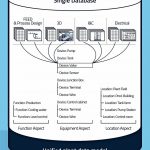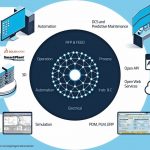The basis for this is the Engineering Base (EB) update Version 2018, Aucotec’s collaborative platform. The idea for it was born a good 18 years ago, and it was designed from the outset for multi-user capability and parallelised processes. “We noticed a great demand in the market to tear down the workflow obstacles created by toolchains. Only true parallelisation of the core tasks results in effective leaps in efficiency despite increasing complexity. This is why we’re convinced of the potential of a data model that unites the engineering disciplines”, says Uwe Vogt, Member of the Aucotec AG Management Board. The company has been operating successfully in the market for over 30 years now with engineering software for mechanical and plant engineering, and has continuously driven the expansion of EB since its introduction.
“For the time being, it’s ‘mission accomplished’! EB’s versatile data model integrates a range of disciplines and achieves collaboration capability and seamlessness that are globally unique”, Vogt continues. “ EB 2018 reorganises the workflow in plant engineering: it eliminates unnecessary waiting times for data transfers, cross-checks that tie up expertise, consultations and synchronisation through highly efficient, simultaneous working. That’s vital for efficient and consistent collaboration.”
Toolchain as an obstacle
Even the best interfaces and synchronisation platforms with the most modern transfer standards do not make a toolchain any shorter. The chain itself is the obstacle because forwarding information takes time, is always a source of error and prevents parallelisation. “That increases exponentially with every chain link and every connection”, explains Pouria G. Bigvand, Head of Product Management at Aucotec.
In a toolchain, for example, it is necessary to specifically ensure that the device designations are the same in all disciplines because synchronisation is otherwise impossible. In addition, inconsistencies result from the different formats, standards, languages or engineering methods used by individual special tools, which a synchronisation platform cannot even record. “This means that losses in quality and time are inevitable. And the more complex the range of tools, the greater the risks”, he adds with conviction.
Unity copes with diversity
As Bigvand emphasises, “Our customers’ challenges clearly show that only unity can cope with diversity”. This is ensured by EB’s unified plant data model. All core disciplines, from basic engineering with FEED up to the pre-commissioning cause & effect check, use it jointly, in parallel and even simultaneously. They can base their specifications directly on the information that colleagues from other departments have just created, because they see it immediately with no need for data transfers and interfaces or for synchronisation.
It is also much easier to integrate simulation, ERP or 3D systems, for instance, if unity exists. A web connection for cloud and app engineering additionally facilitates worldwide collaboration and makes it more flexible.
From FEED to operation
Seamlessness starts with the FEED phase. It initially benefits from EB’s openness and automatically imports the results from the simulation, for example with Aspen or Etap. PFDs and worksheets immediately take over the calculations: EB 2018 shows all consequences of a particular scenario from the rough flow diagram to the material balance – automatically and in separate documents.
The process design then “simply” has to add its specifications to the FEED scenario that is ultimately commissioned. The P&ID represents the collaborative core of all relevant disciplines and its definitions are the starting point for all further elaborations. “That’s one more reason to allow all areas to access this data directly”, Bigvand comments. EB speeds up the creation of the flow diagram, amongst other things, with a pipe class-specific workflow and rule-based engineering. This ensures, for example, that the entire equipment assigned to a particular pipe is automatically adapted to the specifications for the pipe class concerned, for which TÜV certification is also available on request.
Central means consistent
A plant is thoroughly tested with the help of cause and effect documents prior to commissioning. According to Bigvand, this phase once again benefits especially from EB’s versatile data model. C&E tables which are absolutely reliable are key here. Up to now, they have been created by compiling information from different sources and different disciplines, for example from P&IDs, logic diagrams or other documents. Several highly qualified experts spend weeks on this task every time. EB, on the other hand, extracts all necessary information from its central data source and automatically creates the report matrix. This ensures unprecedented consistency and frees up important engineering capacity.
The platform’s seamlessness continues with support for plant operation, firstly with web-based maintenance functions in the form of apps and secondly with special execution management for major conversion and expansion projects. This also works with subcontractors or on multiple contract levels. EB 2018 additionally ensures that the new data is restored to the updated “as is” status in an orderly and consistent way.
Advanced change management
At the same time, a uniform data model of the plant means significantly more efficiency in the event of changes. With EB, if desired, every change in every discipline directly affects all representations of the changed object in graphics, tables or Explorer and is visible to all areas. “However, parallel editing of the model by different experts and departments calls for advanced change management”, Bigvand stresses. According to him, the platform meets this requirement with a whole host of functions including a detailed, individually configurable history log for each individual object as well as particularly transparent revision and version management. Furthermore, EB provides recommendations for attributes, thus enabling change requests to be checked before they are implemented.
“The seamlessness and consistency of this solution result in a completely new level of efficiency, while also ensuring that it is future-proof in the sense of smart factories and Industry 4.0. The combination of parallelised tasks, central data and openness to complementary tools sets a new benchmark”, board member Vogt concludes.
Online search: cpp0218aucotec
Hall 9.2, Booth B12










